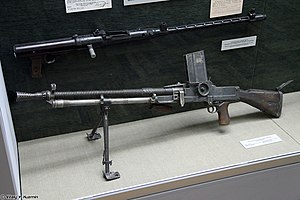ZB vz. 26
| Vz. 26 | |
|---|---|

vz. 26 at the Great Patriotic War Museum.
|
|
| Type | Light machine gun |
| Place of origin | Czechoslovakia |
| Service history | |
| In service | 1926–Present (Upgraded versions in the Paraguayan Army) |
| Used by | See Users |
| Wars |
Second Sino-Japanese War Chaco War Spanish Civil War World War II Korean War Chinese Civil War Indochina War Vietnam War Biafran war Soviet-Afghan War Yugoslav Wars |
| Production history | |
| Designer | Václav Holek |
| Designed | 1924 |
| Manufacturer | Zbrojovka Brno, Military Technical Institute Kragujevac |
| Produced | 1924–1945 |
| Variants | See Variants |
| Specifications | |
| Weight | 10.5 kg (23.15 lb) |
| Length | 1,150 mm (45.3 in) |
| Barrel length | 672 mm (26.5 in) |
|
|
|
| Cartridge | 7.92×57mm IS |
| Action | Gas-operated, tilting breechblock |
| Rate of fire | 500 rounds/min |
| Muzzle velocity | 744 m/s (2,441 ft/s) |
| Effective firing range | 1,000 m (1,100 yd) |
| Feed system | 20-round detachable box magazine |
| Sights | Front blade, rear leaf sight |
The ZB vz. 26 was a Czechoslovak light machine gun developed in the 1920s, which went on to enter service with several countries. It saw its major use during World War II, and spawned the related ZB vz. 27, vz. 30, and vz. 33. The ZB vz. 26 influenced many other light machine gun designs including the Bren light machine gun and the Type 96 Light Machine Gun. The ZB-26 is famous for its reliability, simple components, quick-change barrel and ease of manufacturing. This light machine gun in the Czechoslovak army was marked as the LK vz. 26 ("LK" means "lehký kulomet", light machine gun; "vz." stands for "vzor", Model in Czech). ZB vz. 26 is incorrect marking because "ZB-26" is a factory designation (Československá zbrojovka v Brně), while "vzor 26" or "vz. 26" is an army designation.
In around 1921 the military of the young Czechoslovakian state embarked on a quest for a light machine gun of their own. Early trials included foreign designs such as Berthier, M1918 Browning automatic rifle, Darne machine gun, Hotchkiss M1914 machine gun, Madsen machine gun, St. Étienne Mle 1907, and several domestic designs. Of these, the most important was the Praha II, a lightweight, belt-fed weapon built at Česka Zbrojovka (CZ) Praha (Czech Arms factory in Prague). Development of the ZB-26 began in 1923 after the Czechoslovak Brno arms factory was built. Since CZ-Praha was a relatively small factory with limited industrial capabilities, it was decided to transfer the production of the new automatic weapon to the more advanced Zbrojovka Brno, or ZB in short. This transfer resulted in a long series of court trials over royalties, between the owners of the design (CZ-Praha) and the manufacturer (ZB). Designer Václav Holek was charged by the Czechoslovak army with producing a new light machine gun. He was assisted by his brother Emmanuel, as well as two expatriate Poles: Marek and Podrabsky. Holek was a genius as a firearms designer; he quickly began work on the prototype on the Praha II and within a year the quartet had created an automatic light machine gun that was later known as the ZB. Before long, the Holek brothers abandoned the belt feed in favor of a top-feeding box magazine and the resulting weapon, known as the Praha I-23, was selected. Despite the past legal troubles, manufacture of the new weapon had commenced at the ZB factory by late 1926, and it became the standard light machine gun of the Czechoslovak Army by 1928.
...
Wikipedia
